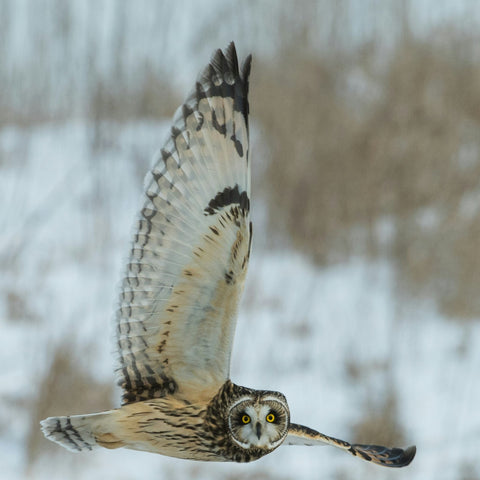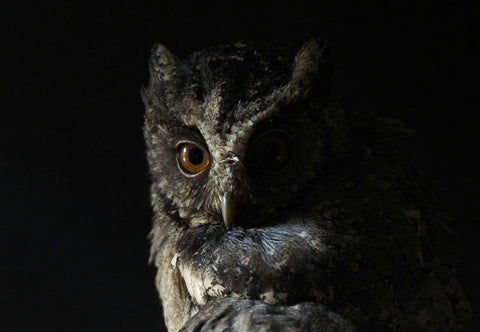Join us on a journey into the heart of the night sky as we unravel the enigmatic secrets of these majestic birds of prey. Prepare to be captivated, for in the realm of owls, mysteries abound and wonders await those who dare to venture into the depths of the night.
In the realm of birds, few creatures capture the imagination quite like owls, their scientific name being: Strigiformes. With their haunting calls and enigmatic eyes, these nocturnal hunters have fascinated humans for centuries. But beneath their cloak of mystery lies a wealth of intriguing facts and evolutionary wonders waiting to be discovered. Amazingly there are 254 specifies of owl and one of the specifies of owl, the Burrowing Owl, live underground!
1. Masters of silence

One of the most remarkable aspects of owls is their stealthy hunting prowess. Owls possess specialised feathers that enable them to fly silently through the night sky. A remarkable adaptation that sets them apart from other birds of prey. Unlike the smooth feathers found on many bird species, owl feathers have serrated edges, similar to the teeth of a comb.
These serrations serve a crucial purpose in disrupting airflow during flight. As an owl flies, air rushes over its wings, creating turbulence and noise. However, the serrated edges of owl feathers break up this airflow into smaller, quieter currents. This disruption minimises the sound produced as the owl moves through the air, essentially muffling its flight.
Additionally, the surface of owl feathers is covered in fine, velvety structures. These structures further dampen sound by absorbing any remaining noise created during flight. Together, the serrated edges and velvety texture of owl feathers contribute to their silent flight, allowing them to approach prey undetected.
The ability to fly silently gives owls a significant advantage when hunting. Unlike other predators whose approach might be announced by the sound of flapping wings, owls can glide through the night with near-complete silence. This stealthiness allows them to get close to their prey without alerting them, increasing their chances of a successful hunt.
When an owl spots its target, whether it's a small mammal, bird, or insect, it can descend with remarkable precision. The element of surprise, combined with their silent flight, makes owls truly formidable hunters, earning them the well-deserved title of "masters of silence."
In summary, owls' specialised feathers, with their serrated edges and velvety texture, play a crucial role in enabling silent flight. By minimising turbulence and absorbing sound, these feathers allow owls to approach their prey undetected, showcasing their incredible hunting prowess in the darkness of the night.
2. The eyes of the night

Owls are renowned for their large, forward-facing eyes, which grant them exceptional night vision. But here's where it gets truly fascinating: owls are capable of rotating their heads up to 270 degrees, allowing them to scan their surroundings without moving their bodies! This incredible range of motion, combined with their acute vision, makes owls formidable hunters in the darkness.
- Flexible Neck Structure: Owls have incredibly flexible necks due to the unique structure of their cervical vertebrae. Unlike humans and many other animals, owls have more cervical vertebrae, and these vertebrae are equipped with specialized adaptations. The arteries and veins in the neck are also designed to allow for unrestricted blood flow, even during extreme neck rotations.
- Flexible Blood Vessels: The blood vessels in an owl's neck are uniquely adapted to accommodate the extreme movements of their necks. These vessels are equipped with extra padding and elasticity, allowing them to stretch and compress as the owl rotates its head. This prevents blood flow from being restricted, ensuring that the owl's brain and other tissues receive a continuous oxygen supply.
- Limited Range of Motion: While it's true that owls can rotate their heads up to 270 degrees, they cannot perform a full 360-degree rotation. This limitation is due to anatomical constraints, such as the arrangement of muscles, tendons, and blood vessels in the neck. However, the ability to turn their heads to such an extent still provides owls with a remarkable field of view without having to move their bodies.
- Binocular Vision: Owls have large, forward-facing eyes that provide them with binocular vision, meaning they can focus on objects with both eyes simultaneously. This depth perception is crucial for accurately judging distances, especially when hunting prey in low light conditions. By rotating their heads, owls can align their binocular vision with their target, allowing for precise aiming and striking.
- Enhanced Hunting Abilities: The combination of flexible necks and exceptional night vision gives owls a significant advantage when hunting. They can remain concealed while scanning their surroundings for potential prey, and when they spot a target, they can swiftly rotate their heads to focus on it without alerting their prey. This ability to move with stealth and precision makes owls highly effective predators in the darkness of the night.
3. Evolution of nocturnality

But how did owls become nocturnal creatures in the first place? The answer lies in their evolutionary history. Millions of years ago, owls' ancestors were diurnal hunters, competing with other birds of prey for food and territory. However, as forests expanded and daytime predators proliferated, some species of owls began to adapt to a nocturnal lifestyle to avoid competition and predation.
Over time, natural selection favoured individuals with traits conducive to nocturnal hunting, such as keen hearing, exceptional night vision, and silent flight. These adaptations allowed owls to carve out a niche in the nighttime ecosystem, where they reign supreme as the undisputed rulers of the dark.
4. Cultural significance
Beyond their biological marvels, owls hold a special place in human culture and folklore Throughout history, owls have often been linked to deities, spirits, or supernatural entities, due to the reasons we touch on above. In many societies, owls are revered as symbols of wisdom, mystery, and magic. From ancient Greek mythology, where the owl was associated with Athena, the goddess of wisdom and strategy. Owls were considered sacred to Athena and were seen as her companions, embodying her qualities of intelligence and foresight. Similarly, in other cultures, owls were believed to be guardians or messengers of the spirit world, further enhancing their mystical reputation. Another example is Native American folklore, where owls are believed to possess supernatural powers, these majestic birds have left an indelible mark on the human psyche.
Conclusion
As the silent sentinels of the night, owls embody the untamed beauty and intrigue of the natural world. From their stealthy hunting techniques to their mesmerizing eyes, these enigmatic creatures continue to captivate and inspire us with their mysterious ways. So the next time you hear the hoot of an owl echoing through the darkness, take a moment to appreciate the wonders of the nocturnal world.
Do you love these creatures or do you think they are sinful?






















